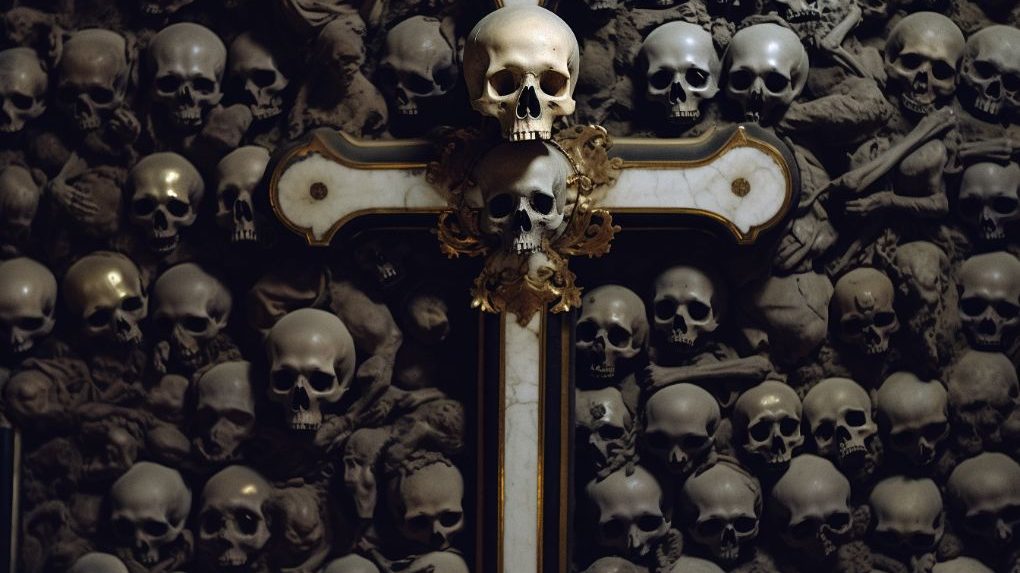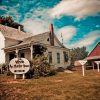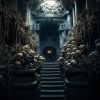Nestled within the quaint town of Kutná Hora in the Czech Republic, the Sedlec Ossuary, or the “Bone Church,” captivates all who visit this small Gothic church.
This unique site from medieval times, dramatically adorned by human skeletal remains, holds a history as rich and complex as the patterns of bones that embellish its interior.
From Humble Cemetery church to a World Heritage Site
The interesting story of the Sedlec Ossuary began in the 13th century, predicated by a seemingly ordinary event. The abbot of the Sedlec Cistercian Monastery undertook a pilgrimage to the Holy Land, returning with a jar of soil from the sacred grounds of Golgotha. Upon scattering this holy soil across the Sedlec Cemetery grounds, the local burial site swiftly gained renown as a coveted final resting place, sowing the seeds for what would become a legendary ossuary.
The cemetery’s fame surged anew with the Black Death in the mid-14th century and the Hussite Wars in the early 15th century, events that significantly swelled the number of burials. It soon became apparent that a more creative solution was necessary to accommodate the burgeoning graveyard. As the cemetery burgeoned, the idea to construct an ossuary took root. The task of exhuming skeletons and stacking their bones within the church fell to a half-blind monk in the 15th century, beginning the transformation of this ordinary cemetery church into the world-renowned “Church of Bones.”
Over the centuries, the ossuary evolved under the hands of numerous custodians until František Rint, a woodcarver, was employed in 1870 by the Schwarzenberg family to put the bone heaps in order. Rint’s artistic touch led to the creation of the ossuary’s breathtaking bone constructs, including the Schwarzenberg coat of arms and the enormous chandelier containing at least one of every human bone, propelling the site to international fame.
Today, the Sedlec Ossuary stands as a UNESCO World Heritage site, a testament to its historical and cultural significance. It draws innumerable visitors, all eager to wander through its macabre yet serene interior, reflecting on the transient nature of life.
The Sedlec Ossuary: A Detailed Exploration
Venturing into the heart of the Sedlec Ossuary introduces visitors to an unsettling yet strangely harmonious scene. Human bones, numbering tens of thousands arranged with an artist’s precision, create an atmosphere that whispers tales of the past. Each component, from the garlands of skulls to the grand bone chandelier, contributes to the ossuary’s thought-provoking ambiance.
Artistic Display of Human Bones
Within the ossuary, bones cease to be mere skeletal remains. They become art, creating ornate patterns on the walls and ceiling. The creativity employed in these arrangements highlights a deep respect for the deceased, transforming each individual’s final resting place into a part of something communal and eternal. This artistic phenomenon reflects a ‘memento mori’ perspective, reminding viewers of their mortality and the swift passage of life.
The Enormous Chandelier of Bones and Other Structures
Central to the ossuary’s many displays is the enormous chandelier, a skeletal medley comprising every bone in the human body. This masterpiece, intricate in its design, symbolizes a chalice of life balanced by the stark reality of death. Alongside, the Schwarzenberg coat of arms, crafted meticulously from bones, commemorates the noble family’s contribution while demonstrating the ossuary’s historical ties to nobility and conflict.
The Schwarzenberg Coat of Arms
A more detailed examination reveals the coat of arms as a narrative in itself. It showcases the Schwarzenberg family’s victories, with the most prominent feature being a raven pecking at the severed head of a Turk, a reference to the family’s triumphs in battles against the Ottoman Empire. This display, while macabre, speaks volumes of the era’s turbulent history and the ossuary’s role in commemorating those who shaped it.
The Historical Context and Symbolism of the Sedlec Ossuary
Understanding the Sedlec Ossuary requires peering into the past, exploring the symbolic undercurrents that guided medieval thought and the tumultuous events that shaped Central Europe.
Memento Mori: The Medieval Concept of Remembering Mortality
The concept of ‘memento mori,’ or remembrance of death, pervaded much of medieval consciousness, with the ossuary serving as a profound expression of this philosophy. The displays, rather than being mere morbid curiosities, are physical manifestations of the era’s contemplations on death, intended to remind viewers of life’s ephemeral nature and the inevitability of death.
The Hussite Wars and Their Impact on the Ossuary
The 15th century was rife with religious strife, and the Hussite Wars were no exception. These conflicts contributed significantly to the number of interments in the Sedlec Cemetery, turning the modest graveyard into a mass burial site. The aftermath necessitated the creation of the ossuary, a silent witness to the violence that once swept through the Czech lands.
The Black Death: A Catalyst in the Ossuary’s History
The Black Death, one of history’s most devastating pandemics, left an indelible mark on the ossuary. The surge in fatalities during this period swelled the cemetery’s ranks, with the church becoming an integral part of managing this aspect of the crisis. It stands as a monument to resilience in the face of unparalleled adversity.
The Creators of the Bone Church
The Sedlec Ossuary owes its existence and unique charm to several figures who, driven by faith, duty, or artistic vision, contributed to the creation and transformation of this remarkable site. Their stories are as woven into the fabric of the ossuary as the skeletal remains that adorn it.
The Half-Blind Monk’s Initial Endeavor
The initial architect of the bone church’s interior was a half-blind monk, tasked by the local abbot with the exhumation and stacking of bones. This monk, whose name history did not preserve, was the first to turn necessity into a form of artistry, creating the ossuary’s initial layout. His work set a foundational tone of reverence, framing death not as something to fear but as a natural step in the journey of existence.
Frantisek Rint: The Woodcarver Behind the Bone Artistry
However, it was Frantisek Rint, a woodcarver employed by the Schwarzenberg family, whose vision brought the ossuary to its current form. Rint’s contribution in the 19th century was transformative, creating not only arrangements of bones but also meaningful art. His signature is still visible on the ossuary wall, a testament to his life and work. From the chandelier that holds every type of human bone to the Schwarzenberg coat of arms, Rint’s influence is indelible, echoing the ethos of memento mori but also infusing the space with a profound sense of identity and history.
Related: Past Life Regression for Kids: How to Help Them Explore Their Memories
Visiting the Sedlec Ossuary: A Traveler’s Guide
In modern times, the Sedlec Ossuary continues to beckon travelers from around the world, offering a deeply moving experience steeped in history and contemplation. For those seeking to visit, understanding the logistics and what to expect is key to appreciating the site’s profound impact.
How to Visit Sedlec Ossuary: Day Trip from Prague
The ossuary is conveniently accessible for visitors staying in Prague, with various transport options facilitating a seamless day trip. Kutná Hora, the larger locale housing Sedlec, is a short train ride from Prague’s main station, offering a scenic journey through the Czech countryside.
Upon arrival in Kutná Hora, visitors find the ossuary a short walk from the train station, with signage guiding the way through the historic centre. The proximity of Kutná Hora’s other historic sites makes for a comprehensive cultural experience.
Purchasing tickets online in advance is recommended, especially during peak tourist seasons. Entry fees contribute to the preservation efforts, ensuring future generations can also ponder the site’s universal message. Photography may be restricted, emphasizing a respectful experience.
What to Expect During Your Visit
Expect a solemn atmosphere, a far cry from typical tourist attractions. The space, while compact, is dense with symbolism and artistic expression, requiring time for reflection. The upper chapel offers a stark contrast to the ossuary beneath, adorned with traditional religious art and symbols, providing context to the bone arrangements below.
It represents the celestial ascent, believed by the faithful to follow earthly death. Maintaining a respectful decorum is paramount. Speaking in hushed tones, avoiding flash photography, and refraining from touching the bones is standard etiquette, honoring the site’s sanctity and the memory of those interred within.
The Sedlec Ossuary in Contemporary Culture
In the shadow of its macabre beauty and deep historical roots, the Sedlec Ossuary transcends time, influencing contemporary art, literature, and popular culture, becoming not just a silent remnant of the past but a pulsating icon that continues to inspire, awe, and educate.
The Ossuary’s Influence on Art and Popular Culture
The unique aesthetic of the bone church has permeated modern artistic expressions, influencing everything from gothic fashion designs to the motifs of heavy metal music genres. Filmmakers, novelists, and visual artists draw inspiration from its chilling yet serene ambiance, using it as a backdrop that symbolizes themes of mortality, the afterlife, and the human condition. Moreover, the ossuary holds a mirror to society’s fascination with death, often serving as a central element in horror or historical fiction, exploring the dichotomy between life and death.
Preservation Efforts for Future Generations
Preserving the Sedlec Ossuary for posterity is no small task, given its delicate nature. Restoration and conservation efforts are ongoing, often spearheaded by local and international heritage organizations. These activities ensure the structural integrity of the bone arrangements and the church, safeguarding against the wear and tear caused by environmental conditions and the passage of time. Furthermore, the preservation endeavors extend to educational programs, emphasizing the ossuary’s historical significance and cultural value, ensuring that future generations retain the lessons it embodies.
The Enduring Allure of the Bone Church
The Sedlec Ossuary, a small underground chapel in the Czech Republic, stands as a profound testament to the journey through life and beyond. Within its walls, visitors from around the world find themselves confronted by the visual manifestation of mortality, a reminder of the transitory nature of human existence. Yet, it is not just a chapel of bones; it is a chronicle of human history, of wars fought, lives lost, and communities forever changed.
From its inception in the 13th century to its role in contemporary culture, the bone church continues to fascinate, inspire, and intrigue. Through the artistic arrangement of skeletal remains, it tells a story that resonates with each observer, offering a deeply personal experience in the collective narrative of humanity.
Its lessons, both implicit and explicit, coupled with the sheer artistic audacity displayed by Frantisek Rint and those before him, culminate in an encounter that lingers long after one departs its hallowed, subterranean chambers. In a world perpetually racing towards the future, the Sedlec Ossuary offers a solemn pause, an invaluable chance for reflection, and a stark memento mori in bone and silence.



